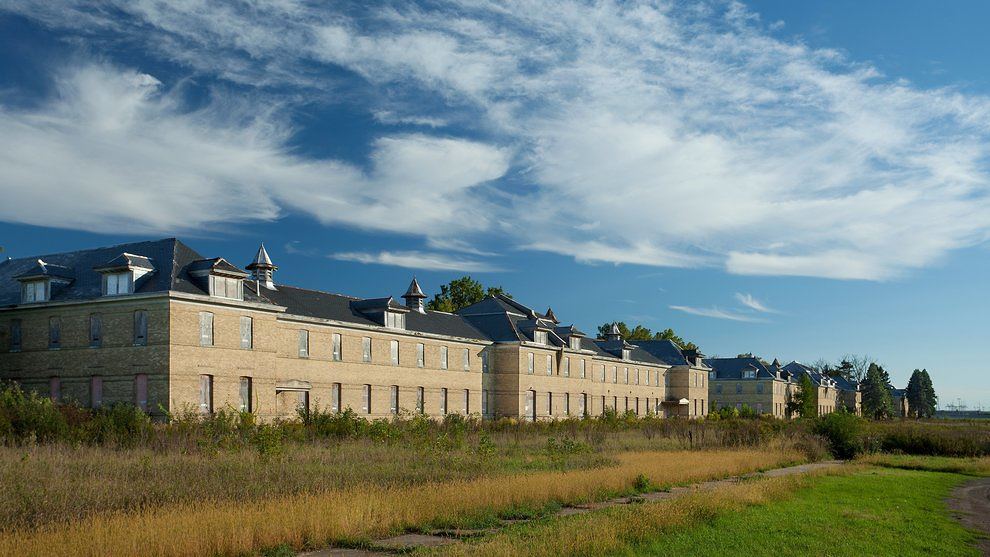Fort Snelling project secures affordable housing financing while costing $900,000 per unit to build
by Max Nesterak
A plan to save 26 crumbling buildings at Fort Snelling’s Upper Post and turn them into moderately priced apartments for veterans narrowly secured critical financing on Tuesday, with the Hennepin County commissioners voting to issue $88 million in bonds to Plymouth-based developer Dominium.
The Upper Post Flats will include 191 apartments with a projected total cost of about $172.5 million — or $902,893 per unit, which is more than three times the cost of the average single family home in the Twin Cities
Three of the the seven Hennepin County commissioners — Mike Opat, Angela Conley and Irene Fernando — voted against the financing, citing the price. (The commissioners technically voted as the Housing Redevelopment Authority, which is made up of the same people as the Board, and must vote again on the bonds during their board meeting in two weeks.)
“I think the cost at $900,000 a unit is exorbitant,” Opat said. “I think that’s just too much, especially for a project that at the end of it isn’t for use by the general public.”
The approval caps off a yearslong fight for public financing — with Dominium pushing through a special state law in 2018 to circumvent a cost ceiling — to build what will be the most expensive affordable housing development per unit in Minnesota history.
The project pits historic preservation against limited resources available to build affordable housing amid a worsening housing and homelessness crisis in the region.
Preserving historic buildings, mitigating noise pollution from the nearby airport and cleaning up hazards like lead paint, asbestos and contaminated soil are all costly. For people who see the Upper Post as part of the state’s most important landmarks, it’s well worth the price.
“If we don’t preserve this now, it will not be preserved,” said Commissioner Debbie Goettel, who noted as mayor of Richfield she saw multiple failed attempts to preserve the site due to lack of funding. “These are historic buildings. I want them preserved. And I think putting people who need houses into these is great.”
The Fort Snelling Upper Post Site was built beginning in 1879 and over the years served as a Japanese language and intelligence school and a rehabilitation center for wounded veterans before it was decommissioned in 1946 and transferred to the Department of Natural Resources. Since then, the buildings have fallen into such disrepair it was named one of the most endangered places by the National Trust for Historic Preservation.
In addition to the money approved Tuesday, Dominium has pulled together a combination of private and public money, including historic preservation tax credits and low-income housing tax credits to finance the development, which is situated on 41 acres.
The project has found detractors on both ends of the political spectrum. But it has received bipartisan support as well, in part because the project tells a compelling story: A historic military site at risk of being lost to neglect will be renovated into affordable housing for veterans.
But the image that the word “affordable” conjures — of homeless veterans moving off the street and into meticulously renovated apartments — is not quite accurate.
Affordable, in this development, means average Twin Cities rent. The units are reserved for people making 60% of the area median income or less, currently about $43,000 (or $62,000 for a four-person household). Rents will be capped around $1,200 for a one-bedroom and $1,400 for a two-bedroom — the same as the average rent for one- and two-bedroom apartments in the Twin Cities.
Although Dominium will give preference to veterans, it’s not required to rent to veterans exclusively. Dominium may accept non-veterans while also turning veterans away if they don’t make enough money, have poor rental history or are otherwise not attractive tenants.
Native Americans serve in the military at the highest rate of any group, but the average Native resident of Hennepin County would not be able to afford to live at the Upper Post Flats. The same is true for Black residents, who also serve in the military at high rates. Both groups are the most likely to have experience homelessness.
“The average income for Black individuals in Hennepin County is $30,000, and you have to be making $43,000. So we just can’t afford to live in this development,” said Conley, who is the first Black person to serve on the Hennepin County Board. She won her seat in 2018 from one of the earliest and most ardent supporters of the Upper Post Flats project, Peter McLaughlin.
“The average income is even lower for Native Americans, for whom this land specifically is sacred,” Conley added.
Dominium argues that more housing is needed at all levels of affordability. Although they are not obligated to accept Section 8 vouchers, Dominium says they will, which would make the Upper Post Flats apartments affordable to people making as little as 30% of the area median income, or about $15,270 for a single person.
Paula Prahl, Dominium’s vice president for Public Affairs, said Dominium plans for about about half of the residents of the Upper Post Flats to have housing vouchers.
While the apartments must stay moderately priced at first, they won’t necessarily stay that way. The public funding Dominium receives only requires the project to be affordable for 30 years, after which they could flip to whatever the market will pay, or Dominium could go back to the government for more funding to keep them affordable.
The project’s development cost has raised eyebrows ever since Dominium first proposed it.
In 2017, the Minnesota Housing Finance Authority Board voted unanimously to deny Dominium’s request for bonding because it was so expensive to develop and wouldn’t serve the poorest Minnesotans in need of housing. The tax credits Dominium will use typically create housing for people making far less money.
“The board thought it was unfair to finance the project on the backs of affordable housing resources,” Ryan Baumtrog, assistant commissioner for policy at the agency, told the Star Tribune in 2018. “We have to use scarce resources to meet statewide needs for first-time homeownership and rentals, and one of the reasons the board said ‘No’ was because of the high cost trade-off.”
Then, the developer used two lobbying firms to muscle through a new state law declaring the Fort Snelling Upper Post “a strategic priority of the state,” prohibiting the state’s housing authority from considering “any per-unit cost limitations or other similar restrictions.”
Since then, the estimated costs have increased 64% from $550,830 per unit two years ago to $902,893 per unit today. The ultimate price tag of the project is likely to be higher still as construction seldom finishes under budget.
Commissioner Irene Fernando questioned Dominium on why the estimated cost increased $38 million just from last year when the Board was asked to give the project preliminary approval.
Dominium Vice President and Project Partner Owen Metz chalked it up to bad guesswork on the structural and environmental challenges the project poses, which he says have come into sharper focus in the past year.
“It was a very bad guess on our part,” Metz said. “This is an extremely complicated development … We’re not overspending where we don’t need to and I assure you we’re doing everything we can to keep costs as low as possible.”
The project will receive $58 million in historic preservation tax credits (about half from the state and half from the federal government). They’ll also receive $63 million in federal low income housing tax credits, for which they’re required to issue private activity bonds like the ones Hennepin County approved on Tuesday.
Prahl, with Dominium, said the cost of the project is in line with similar housing developments. Once you factor out the cost of historic preservation — about 60% of the development cost — the Upper Post Flats will cost about $330,000 to build. She declined to comment on the state’s estimate that a reasonable cost for a similar project would be $247,108.
Prahl said they plan to defer the developer’s fee on the project, but they will make money through operating the property. Dominium is one of the largest private landlords in Minnesota and manages 30,000 apartments across 21 states.
After passing through Hennepin County, the project will once again go before the state’s housing authority on Thursday to receive a waiver for exceeding the state’s cost containment threshold.
The agency notes the cost is higher than what they believe is reasonable, but write “in light of the limitations imposed on the Agency . . . staff ask the Board to adopt the resolution to grant a waiver.”
Dominium has found a niche in redeveloping historic buildings using multiple historic preservation and affordable housing tax credits, which are government programs aimed at increasing the supply of affordable housing.
They turned the old Schmidt Brewery in St. Paul into artist lofts for $470,000 per unit and did the same with three old warehouses to make the Carleton Artist Lofts for $430,000 per unit.
They also redeveloped the Pillsbury A-Mill in one of the most desirable pieces of real estate in Minneapolis for $665,000 per unit. The A-Mill artist lofts include 15-foot ceilings, underground parking, a yoga studio and a rooftop patio with views of downtown just on the other side of the Mississippi River. The rents range from about $1,100 for a studio to $1,400 for a two-bedroom.
Residents of these buildings skew much younger, whiter and richer than people who typically need subsidized housing, according to a 2016 study by the University of Minnesota. Residents of Dominium’s historic redevelopments in up-in-coming neighborhoods are also much less likely to have children or have a housing voucher like Section 8.
The University of Minnesota researchers cheekily named these kinds of developments “POSH” — Politically Opportune Subsidized Housing.
Margaret Kaplan, president of the Housing Justice Center, said projects like Upper Post Flats undercut housing advocates’ message that the state needs to spend more money on affordable housing.
“It’s not just using finite resources for this project that is so expensive,” said Margaret Kaplan, president of the Housing Justice Center. “It also diminishes our argument that we need more resources for affordable housing. These big projects get weaponized against affordable housing, with people saying we don’t need more money for housing, we just need to spend it better.”
Max Nesterak is the deputy editor of the Minnesota Reformer, where he reports on labor and housing. Most recently he was an associate producer for Minnesota Public Radio after a stint at NPR. He also co-founded the Behavioral Scientist and was a Fulbright Scholar to Berlin, Germany. This article has been reprinted with permission from the Reformer.




